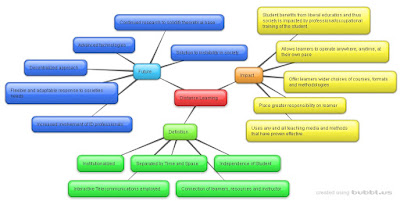I did, however, learn that the
terms e-learning, virtual education/schooling, and on-line learning/education
are not synonymous and are quite independent of each other (Simonson, Smaldino,
Zvacek, 2015). I now know that my work relates to that of an on-line learning
environment under the umbrella of a distance learning theory.
Based on my previous definition,
as well as the information I obtained this week about the various aspects of
distance learning, I believe that the definitive characteristics of distance
learning are always evolving and slightly changing because of the nature of
technology. As society moves to a more technologically advanced state, the use
of such new advancements naturally changes the face of tools used to deliver
distance learning programs. For example, looking back at the history of
distance learning (Simonson, Smaldino & Zvackek, 2015) we can witness how
new technologies advanced the impact and use of distance learning programs from
correspondence study to fully on-line universities.
The challenge with the constant
change of technology is that the theories employed by distance learning practitioners
must also change to support the advancements. There needs to exist a strong
theoretical base by which distance educators can make decisions with confidence
but unfortunately, “the changing and diverse environment in which distance
education is practiced has inhibited the development of a single theory upon
which to base practice and research” (Simonson, et al, 2015, p. 56). As the
world changes technologically, so must distance education programs if they are
to meet the needs of the demands of society.
For this reason, and others, I
strongly believe that distance learning will continue to grow and expand in
influence and impact. I believe this to be due to the fact that drastic changes
in society, politics and economies are impacting the need for education and
training at a much faster pace and because of the flexible and quick nature of
distance learning to meet the rapidly changing needs of the world (Huett,
Moller, Foshay & Coleman, 2008). I also have a strong suspicion that
distance learning will become more impactful at the local level to meet the
needs of specific societies that have diversified more drastically than can be supported.
References:
Huett, J., Moller, L., Foshay, W., & Coleman, C.
(2008c). The evolution of distance education: Implications for instructional
design on the potential of the web (Part 3: K12).TechTrends, 52(5), 636 7.
Retrieved May 8, 2016 from Academic Search Complete.
Simonson, M., Smaldino, S., & Zvacek, S. (2015). Teaching
and learning at a distance: Foundations of distance education. Information
Age Publishing, NC.

No comments:
Post a Comment